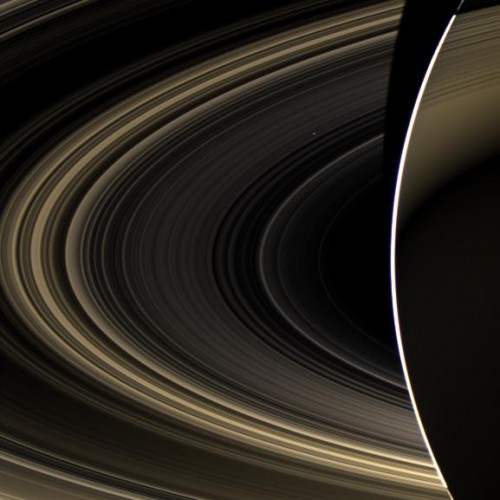
Despite the fact that it is orbiting one of the arguably most beautiful planets in our solar system, NASA’s Cassini spacecraft, orbiting the planet Saturn, opted to snap pics of another, and more hellish, world. Cassini’s target was Earth’s “twin,” the planet Venus. Its highly-reflective clouds peek through Saturn’s rings in the image above.
This is an especially rare vantage point from which to photograph the residents of the inner solar system. According to a NASA press release, this backlit photo was taken in a viewing geometry known as “high solar phase.”
This photo, however, was taken for more than just its aesthetically pleasing aspects. By taking the image in this phase, details about Saturn’s atmosphere can be discerned that would not be possible if taken from a lower phase.
There’s a rationale behind why we refer to these as images and not photographs. AmericaSpace has recently implemented a policy that if a photo is, in actuality, a combination of images, then it is a CGI, illustration, or has been extensively modified. This particular image is a combination of separate red, blue, and green images that were processed together to produce a true-color image.
Venus’ atmosphere is comprised primarily of carbon dioxide; the temperature can reach a toasty 900 degrees Fahrenheit (500 degrees Celsius). The pressure of the planet’s atmosphere is estimated to be some 100 times that of the Earth’s, so standing on the surface would be like standing on the bottom of the ocean. Venus’ clouds are made up of sulfuric acid (this is the reason they are bright and reflect light very well). As stated earlier, it is a hellish world. Venus is sometimes referred to as Earth’s “twin,” as both worlds are terrestrial, similar in size, and orbit close to one another.
NASA has partnered with the European Space Agency, or “ESA,” on the Cassini mission to explore Saturn and its moons. It arrived at the ringed world in 2005.




Spectacular! I recall an image in Aviation Week & Space Technology showing the “pale blue dot” (Earth) taken by the Galileo probe (I believe) looking from behind Saturn toward Earth. What was extraordinary was that mankind built and sent a machine out to that distance and took the image of it own life-bearing planet. It was humbling, to say the least.